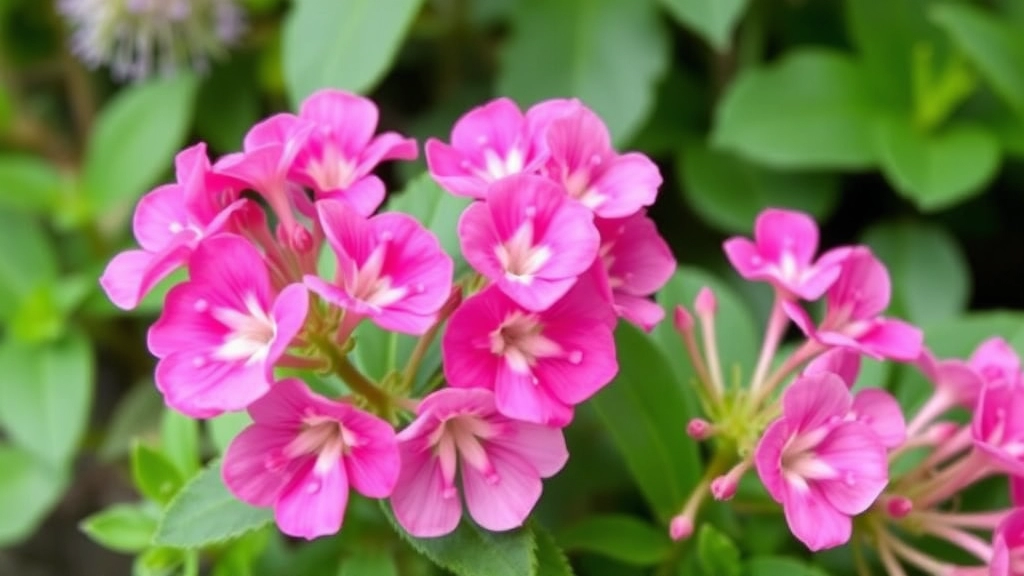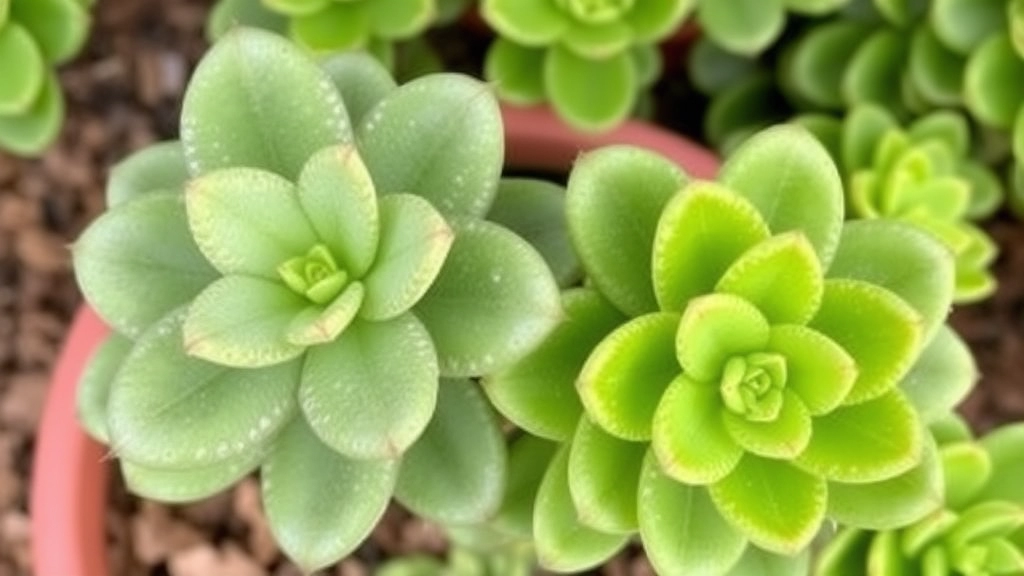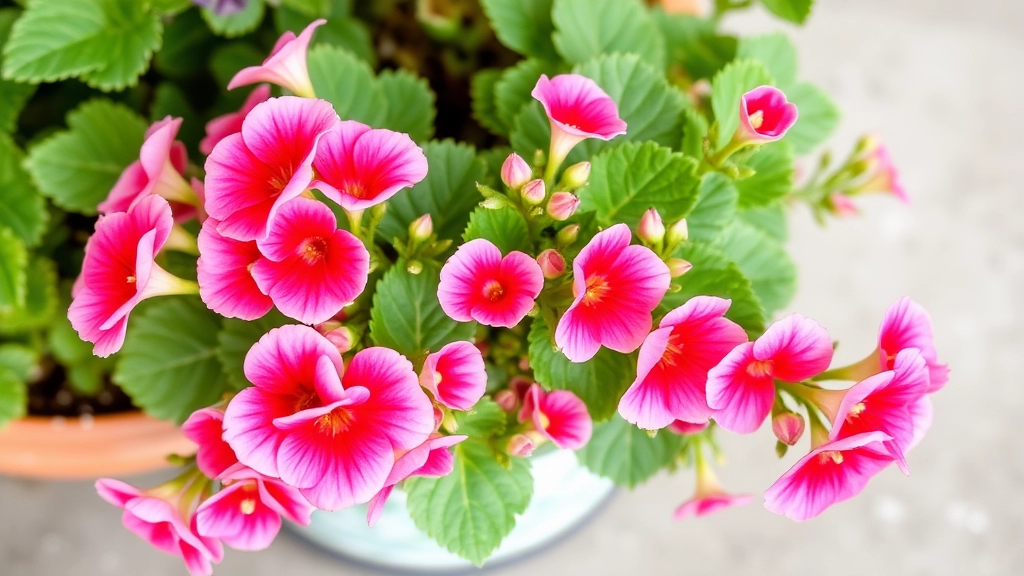Care for Pink Florist Kalanchoe
When it comes to taking care of a Pink Florist Kalanchoe, it’s crucial to get the basics right. This charming succulent thrives in bright, indirect light and needs well-draining soil to prevent root rot. Keep the temperature moderate and maintain a humidity level that isn’t too high. Water your Kalanchoe when the top inch of soil feels dry, but be careful not to overwater.
Encouraging Blooming
Encouraging your Pink Kalanchoe to bloom can be a rewarding experience. To induce flowering, control the light exposure by ensuring the plant gets about 14 hours of darkness each day for six weeks. Adjust your watering schedule during this period to keep the soil slightly drier. With a bit of patience and the right conditions, your Kalanchoe will reward you with beautiful pink blooms.
Proper Care for Pink Florist Kalanchoe
Are you struggling to keep your Pink Florist Kalanchoe thriving?
You’re not alone. Many plant lovers encounter challenges with this vibrant succulent.
To ensure your Kalanchoe flourishes, it’s essential to understand its proper care.
Light Requirements
First and foremost, Pink Kalanchoe loves bright, indirect sunlight.
- Ideal Location: A south or west-facing window is perfect.
- Avoid Direct Sun: Too much direct sunlight can scorch the leaves.
Temperature and Humidity
Kalanchoe thrives in warm environments.
- Optimal Temperature: Aim for 20-25°C (68-77°F).
- Humidity Levels: This plant prefers low to moderate humidity.
Soil and Potting
Choosing the right soil mix is crucial for healthy growth.
- Soil Type: Use a well-draining cactus or succulent mix.
- Pot Selection: Ensure the pot has drainage holes to prevent waterlogging.
Watering Routine
Getting the watering schedule right can make all the difference.
- Frequency: Water when the top inch of soil feels dry.
- Method: Water thoroughly but allow excess to drain away.
Fertilization
Feeding your Kalanchoe can boost its growth and blooming potential.
Tips to Encourage Blooming in Pink Kalanchoe

So, you’ve got a lovely Pink Florist Kalanchoe, and you want it to bloom like a champ, right? I totally get it. Those vibrant pink flowers can really brighten up a space. Let’s dive into some straightforward tips to help your Kalanchoe show off its stunning blooms.
1. Light Matters
- Bright Indirect Light: Place your Kalanchoe where it can soak up bright, indirect sunlight. Too much direct sun can scorch those lovely leaves.
- Rotate Regularly: Give it a little spin every now and then. This helps all sides get equal light, promoting even growth.
2. Temperature Control
- Keep It Cozy: Aim for a temperature between 15°C to 25°C. Avoid cold drafts and sudden temperature changes.
- Nighttime Chill: A slight drop in temperature at night can actually encourage blooming. Just don’t go overboard!
3. Watering Wisely
- Dry Between Waterings: Let the top inch of soil dry out before watering again. This prevents root rot and keeps the plant happy.
- Avoid Overwatering: It’s better to underwater than overwater. Trust me, your Kalanchoe will thank you.
4. Fertilizing
- Use a Balanced Fertilizer: A balanced, water-soluble fertilizer every month during the growing season can work wonders. Look for something with equal parts nitrogen, phosphorus, and potassium.
- Cut Back Before Blooming: Stop fertilizing a month before you want it to bloom to encourage flower production.
5. Pruning for Blooms
- Deadhead Regularly: Snip off spent flowers to encourage new blooms. It’s like giving your plant a little nudge!
- Trim Leggy Growth: If you notice any leggy stems, don’t hesitate to prune them back. This helps the plant focus its energy on blooming.
6. Stress for Success
- A Little Stress Is Good: Believe it or not, a little stress can encourage blooming. Let it dry out slightly or give it a cooler night to trigger those blooms.
Propagating Pink Florist Kalanchoe
Many enthusiasts wonder how to propagate their beloved Pink Florist Kalanchoe. This process can be rewarding and allows you to expand your collection or share with friends.
Methods of Propagation
- Leaf Cuttings:
- Select a healthy leaf from the parent plant.
- Cut the leaf at the base using a clean, sharp knife.
- Allow the cut end to dry for a few days to form a callus.
- Place the leaf in well-draining soil, burying the cut end slightly.
- Water lightly and place in indirect sunlight.
- Stem Cuttings:
- Choose a healthy stem with a few leaves.
- Cut the stem just below a leaf node.
- Let the cutting dry for a day to promote callusing.
- Plant the cutting in a pot with well-draining soil.
- Water sparingly and keep in bright, indirect light.
- Offsets:
- Look for offsets or small pups at the base of the plant.
- Gently separate the offset from the parent plant.
- Replant in a small pot with fresh soil.
- Water lightly and ensure it receives indirect sunlight.
Tips for Successful Propagation
- Timing: The best time to propagate is during the growing season, typically spring or early summer.
- Humidity: Maintain a humid environment for cuttings by covering them with a plastic bag or using a propagation dome.
- Patience: It may take a few weeks for roots to develop, so be patient.
Propagating Pink Florist Kalanchoe not only enriches your gardening experience but also ensures you have more beautiful blooms to enjoy. For more detailed care tips, check out our care tips for Orange Florist Kalanchoe and learn about the flowering period care tips for Kalanchoe Blossfeldiana.
Common Pests and Diseases in Kalanchoe

When caring for your Pink Florist Kalanchoe, it’s essential to be aware of potential pests and diseases that can affect its health.
Common Pests:
- Mealybugs:
- These small, white, cottony insects can be found in leaf joints and on stems.
- They feed on the plant’s sap, leading to wilting and yellowing leaves.
- Aphids:
- Tiny and often green or black, aphids suck sap from new growth.
- They can also lead to sticky residue on leaves, known as honeydew.
- Spider Mites:
- These microscopic pests thrive in dry conditions.
- Look for fine webbing and speckled leaves as signs of infestation.
- Scale Insects:
- Appearing as small, brown bumps on stems and leaves, scale insects can severely weaken the plant.
- They often go unnoticed until the damage is significant.
Common Diseases:
- Root Rot:
- Caused by overwatering and poor drainage, root rot leads to mushy roots and wilting.
- Always ensure your pot has drainage holes and allow the soil to dry out between waterings.
- Powdery Mildew:
- This fungal disease appears as a white powdery coating on leaves.
- It thrives in high humidity and poor air circulation.
- Leaf Spot:
- Characterised by dark spots on leaves, this can be caused by fungal infections or overwatering.
- Prompt action is essential to prevent spread.
Prevention and Treatment:
- Regular Inspection:
- Check your plant weekly for any signs of pests or disease.
- Early detection is key to effective treatment.
- Proper Care:
- Maintain appropriate watering and light conditions to keep your plant healthy.
- Healthy plants are less susceptible to pests and diseases.
- Natural Remedies:
- Use insecticidal soap or neem oil for pest control.
- For fungal issues, consider a fungicide or homemade solutions like baking soda mixed with water.
When it comes to caring for your Pink Florist Kalanchoe, understanding the right watering and fertilizing practices is crucial for its health and vibrancy.
### Watering Guidelines:
– **Frequency:** Allow the top inch of soil to dry out before watering again. Typically, this means watering every 2-3 weeks, but always adjust based on your specific environment.
– **Method:** Water thoroughly until it drains from the bottom. This ensures the roots receive adequate moisture without becoming waterlogged.
– **Signs of Overwatering:** Yellowing leaves or a mushy stem are clear indicators that you may be giving your plant too much water.
– **Signs of Underwatering:** If the leaves start to shrivel or feel crispy, it’s time to give your Kalanchoe a drink.
### Fertilizing Guidelines:
– **Type of Fertilizer:** Use a balanced, water-soluble fertiliser with an NPK ratio of 20-20-20.
– **Frequency:** Fertilize every 4-6 weeks during the growing season (spring and summer). Reduce or stop fertilizing in the fall and winter when the plant is dormant.
– **Dilution:** Always dilute the fertiliser to half strength to avoid burning the roots.
– **Signs of Nutrient Deficiency:** If your Kalanchoe shows stunted growth or pale leaves, it may need a nutrient boost.
By following these watering and fertilizing guidelines, you’ll be well on your way to nurturing a healthy and blooming Pink Kalanchoe. For more detailed care tips, check out this [care guide for Pink Florist Kalanchoe](https://planthq.org/care-tips-for-orange-florist-kalanchoe-blossfeldiana/) and learn how to [propagate your Kalanchoe](https://planthq.org/how-to-propagate-kalanchoe-pink-butterflies-stepbystep-guide/) effectively.
How to Prune and Maintain Pink Kalanchoe for Year-Round Health
Ever wondered why your beautiful pink Kalanchoe isn’t thriving as it should?
Pruning and maintenance are key to keeping your plant healthy and blooming beautifully.
Why Pruning Matters
Pruning isn’t just about aesthetics; it’s essential for the overall health of your Kalanchoe.
Here’s why you should consider it:
- Promotes Growth: Cutting back old or dead leaves encourages new growth.
- Encourages Blooms: Proper pruning can lead to more flowers.
- Prevents Disease: Removing dead or damaged parts helps keep pests and diseases at bay.
When to Prune
Timing is everything.
- After Blooming: The best time to prune is right after the blooming period. This usually happens in late spring.
- Regular Maintenance: Keep an eye on your plant throughout the year. If you see any dead or yellowing leaves, snip them off.
How to Prune Your Kalanchoe
Ready to get your hands dirty? Here’s a simple guide:
- Gather Your Tools: You’ll need clean, sharp scissors or pruning shears.
- Identify What to Cut: Look for:
- Dead or wilted flowers
- Yellow or brown leaves
- Overgrown stems
- Make the Cuts:
- Cut just above a leaf node to encourage new growth.
- Aim to remove about one-third of the plant if it looks too bushy.
Maintenance Tips
Once you’ve pruned, it’s all about keeping your Kalanchoe in tip-top shape.
- Light: Ensure it gets plenty of bright, indirect sunlight.
- Watering: Water when the top inch of soil feels dry.
- Fertilizing: Use a balanced fertilizer every few months during the growing season.
Keeping It Healthy Year-Round
- Dusting: Wipe leaves occasionally to keep them clean and free from dust.
- Check for Pests: Regularly inspect for any signs of pests or disease.
- Repotting: If your Kalanchoe is outgrowing its pot, consider repotting every couple of years.
For more detailed care tips, check out our Kalanchoe Paddle Plant Care Guide and learn about the Complete Guide to Growing and Caring for Kalanchoe Pink Butterflies.
FAQs About Pink Florist Kalanchoe
How much light does a Pink Florist Kalanchoe need?
Bright, indirect light is ideal for a Pink Florist Kalanchoe. Too much direct sunlight can scorch the leaves, so it’s best to place it where it can soak up plenty of indirect sunlight. Regularly rotating the plant helps ensure even light distribution.
What is the best temperature range for Pink Florist Kalanchoe?
Keep the temperature between 15°C to 25°C for optimal growth. Avoid exposing the plant to cold drafts or sudden temperature changes. A slight drop in temperature at night can also encourage blooming.
How should I water my Pink Florist Kalanchoe?
Allow the top inch of soil to dry out before watering again. Overwatering can lead to root rot, so it’s better to underwater than overwater. Make sure the pot has drainage holes to prevent water from accumulating.
What type of fertilizer should I use?
Use a balanced, water-soluble fertilizer with equal parts nitrogen, phosphorus, and potassium once a month during the growing season. Stop fertilizing about a month before you want the plant to bloom to encourage flower production.
How can I encourage my Pink Florist Kalanchoe to bloom?
Regularly deadhead spent flowers and trim leggy growth to help the plant focus its energy on blooming. Additionally, a little stress, such as letting the plant dry out slightly or giving it a cooler night, can trigger blooming.
What are common pests that affect Pink Florist Kalanchoe?
Common pests include mealybugs, aphids, spider mites, and scale insects. Regular inspection can help you catch these pests early. Use insecticidal soap or neem oil for pest control.
What diseases should I watch out for in my Pink Florist Kalanchoe?
Be on the lookout for root rot, powdery mildew, and leaf spot. Ensure proper watering and good air circulation to prevent these issues. For fungal diseases, consider using a fungicide or homemade solutions like baking soda mixed with water.
How can I prevent pests and diseases in my Pink Florist Kalanchoe?
Regularly inspect your plant and maintain appropriate watering and light conditions. Healthy plants are less susceptible to pests and diseases. Early detection is key to effective treatment.
References
-
How to Care for a Kalanchoe Plant
-
Kalanchoe Plant Care: How to Grow and Care for Kalanchoe Plants
-
Kalanchoe: How to Grow and Care for Kalanchoe Plants
